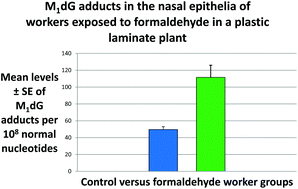Formaldehyde-induced toxicity in the nasal epithelia of workers of a plastic laminate plant
Abstract
Formaldehyde is a ubiquitous volatile organic compound widely used for various industrial purposes. Formaldehyde was reclassified by the International Agency for Research on Cancer as a human carcinogen, based on sufficient evidence for a casual role for nasopharyngeal cancer. However, the mechanisms by which this compound causes nasopharyngeal cancer are not completely understood. Therefore, we have examined the formaldehyde-induced toxicity in the nasal epithelia of the workers of a plastic laminate plant in Bra, Cuneo, Piedmont region, North-Western Italy, hence in the target site for formaldehyde-related nasal carcinogenesis. We have conducted a cross-sectional study aimed at comparing the frequency of 3-(2-deoxy-β-D-erythro-pentafuranosyl)pyrimido[1,2-α]purin-10(3H)-one deoxyguanosine (M1dG) adducts, a biomarker of oxidative stress and lipid peroxidation, in 50 male exposed workers and 45 male controls using 32P-DNA post-labeling. The personal levels of formaldehyde exposure were analysed by gas-chromatography mass-spectrometry. The smoking status was estimated by measuring the concentrations of urinary cotinine by gas-chromatography mass-spectrometry. The air monitoring results showed that the exposure levels of formaldehyde were significantly greater for the plastic laminate plant workers, 211.4 ± 14.8 standard error (SE) μg m−3, than controls, 35.2 ± 3.4 (SE) μg m−3, P < 0.001. The levels of urinary cotinine were 1064 ± 118 ng ml−1 and 14.18 ± 2.5 ng ml−1 in smokers and non-smokers, respectively, P < 0.001. The M1dG adduct frequency per 108 normal nucleotides was significantly higher among the workers of the plastic laminate plant exposed to formaldehyde, 111.6 ± 14.3 (SE), compared to controls, 49.6 ± 3.4 (SE), P < 0.001. This significant association persisted also when personal dosimeters were used to measure the extent of indoor levels of formaldehyde exposure. No influences of smoking and age were observed across the study population. However, after categorization for occupational exposure, a significant effect was found in the controls, P = 0.018, where the levels of DNA damage were significantly correlated with the levels of urinary cotinine, regression coefficient (β) = 0.494 ± 0.000 (SE), P < 0.002. Our findings indicated that M1dG adducts constitute a potential mechanism of formaldehyde-induced toxicity. Persistent DNA damage contributes to the general decline of the physiological mechanisms designed to maintain cellular homeostasis.



 Please wait while we load your content...
Please wait while we load your content...